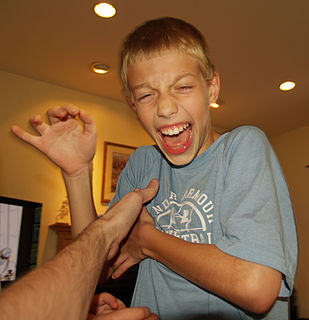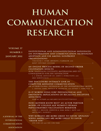
Communication is "an apparent answer to the painful divisions between self and other, private and public, and inner thought and outer world." As this definition indicates, communication is difficult to define in a consistent manner, because it is commonly used to refer to a wide range of different behaviors, or to limit what can be included in the category of communication. John Peters argues the difficulty of defining communication emerges from the fact that communication is both a universal phenomenon and a specific discipline of institutional academic study.

Nonverbal communication (NVC) is the transmission of messages or signals through a nonverbal platform such as eye contact, facial expressions, gestures, posture, and body language. It includes the use of social cues, kinesics, distance (proxemics) and physical environments/appearance, of voice (paralanguage) and of touch (haptics). It can also include the use of time (chronemics) and eye contact and the actions of looking while talking and listening, frequency of glances, patterns of fixation, pupil dilation, and blink rate (oculesics).

Haptic communication is a branch of nonverbal communication that refers to the ways in which people and animals communicate and interact via the sense of touch. Touch is the most sophisticated and intimate of the five senses. Touch or haptics, from the ancient Greek word haptikos is extremely important for communication; it is vital for survival.
Albert Mehrabian was born in 1939 to an Armenian family living in Iran. He isProfessor Emeritus of Psychology at the University of California, Los Angeles. Although he originally trained as an engineer, he is best known for his publications on the relative importance of verbal and nonverbal messages. He also constructed a number of psychological measures including the Arousal Seeking Tendency Scale.
The uncertainty reduction theory, also known as initial interaction theory, developed in 1975 by Charles Berger and Richard Calabrese, is a communication theory from the post-positivist tradition. It is one of the few communication theories that specifically looks into the initial interaction between people prior to the actual communication process. The theory asserts the notion that, when interacting, people need information about the other party in order to reduce their uncertainty. In gaining this information people are able to predict the other's behavior and resulting actions, all of which according to the theory is crucial in the development of any relationship.

Reactance is an unpleasant motivational arousal (reaction) to offers, persons, rules, or regulations that threaten or eliminate specific behavioral freedoms. Reactance occurs when a person feels that someone or something is taking away their choices or limiting the range of alternatives.
Surprise is a brief mental and physiological state, a startle response experienced by animals and humans as the result of an unexpected event. Surprise can have any valence; that is, it can be neutral/moderate, pleasant, unpleasant, positive, or negative. Surprise can occur in varying levels of intensity ranging from very-surprised, which may induce the fight-or-flight response, or little-surprise that elicits a less intense response to the stimuli.
Semantic satiation is a psychological phenomenon in which repetition causes a word or phrase to temporarily lose meaning for the listener, who then perceives the speech as repeated meaningless sounds. Extended inspection or analysis in place of repetition also produces the same effect.
Communication accommodation theory (CAT) is a theory of communication developed by Howard Giles. This theory concerns "(1) the behavioral changes that people make to attune their communication to their partner, (2) the extent to which people perceive their partner as appropriately attuning to them." The basis of the theory lies in the idea that people adjust their style of speech to one another. Doing this helps the message sender gain approval from the receiver, increases efficiency in communication between both parties, and helps the sender maintain a positive social identity. This theory is concerned with the links between language, context, and identity. It focuses on both the intergroup and interpersonal factors that lead to accommodation, as well as the ways that power, macro and micro-context concerns affect communication behaviors. Accommodation is usually considered to be between the message sender and the message receiver, but the communicator also often accommodates to a larger audience- either a group of people that are watching the interaction or society in general.
Action assembly theory is a communication theory that emphasizes psychological and social influences on human action. The goal is to examine and describe the links between the cognition and behavior – how an individual's thoughts get transformed into action. It was developed by John Greene.
Information manipulation theory (IMT) & is a way of looking at interpersonal communication. It deals with the way a sender might assemble information packages to a receiver in order to give an impression that is false from the perspective of the sender. The sender chooses certain facts in the message from an available amount of information—but omits, alters, or falsifies others. The act of trying to get someone to believe something untrue is deceit. The type of communication created by such deceitful intent is called a deceptive message. The senders management of given information to provide a receiver with a false perception of that same information is called information manipulation. Departing from the focus on the communication mode found in Interpersonal Deception Theory (IDT), IMT is more concerned with the content of the deceptive messages, the situational contexts that bring them about, the degree to which the detection of such a message affects perception of deception and the relational consequences associated with deceptive messages.
Language expectancy theory (LET) is a theory of persuasion. The theory assumes language is a rules-based system, in which people develop expected norms as to appropriate language usage in given situations. Furthermore, unexpected linguistic usage can affect the receiver's behavior resulting from attitudes towards a persuasive message.
Charles R. Berger was an American professor emeritus of communication at the University of California, Davis. Berger died on September 25, 2018, from health complications arising from cancer.
Inoculation theory is a social psychological/communication theory that explains how an attitude or belief can be protected against persuasion or influence in much the same way a body can be protected against disease–for example, through pre-exposure to weakened versions of a stronger, future threat. The theory uses medical inoculation as its explanatory analogy—applied to attitudes rather than to a disease. It has great potential for building public resilience ('immunity') against misinformation and fake news, for example, in tackling science denialism, risky health behaviours, and emotionally manipulative marketing and political messaging.
Judee K. Burgoon is a professor of communication, Family Studies and Human Development at the University of Arizona, where she serves as Director of Research for the Center for the Management of Information and Site Director for the NSF-sponsored Center for Identification Technology Research. She is also involved with different aspects of Interpersonal and Nonverbal Communication, deception, and new communication technologies. She is also Director of Human Communication Research for the Center for the Management of Information and Site Director for Center for Identification Technology Research at the university, and recently held an appointment as Distinguished Visiting Professor with the Department of Communication at the University of Oklahoma, and the Center for Applied Social Research at the University of Oklahoma. Burgoon has authored or edited 13 books and monographs and has published nearly 300 articles, chapters and reviews related to nonverbal and verbal communication, deception, and computer-mediated communication. Her research has garnered over $13 million in extramural funding from the National Science Foundation, the Department of Defense, the Department of Homeland Security, the Office of the Director of National Intelligence, Counterintelligence Field Activity, and the National Institutes of Mental Health. Among the communication theories with which she is most notably linked are: interpersonal adaptation theory, expectancy violations theory, and interpersonal deception theory. A recent survey identified her as the most prolific female scholar in communication in the 20th century.
Power and dominance-submission are two key dimensions of relationships, especially close relationships in which parties rely on one another to achieve their goals and as such it is important to be able to identify indicators of dominance.

Interpersonal communication is an exchange of information between two or more people. It is also an area of research that seeks to understand how humans use verbal and nonverbal cues to accomplish a number of personal and relational goals.

Human Communication Research is a quarterly peer-reviewed academic journal covering empirical work in any area of human communication and human symbolic processes. It was established in 1974 and the current editor-in-chief is Eun-ju Lee. It is published by Oxford University Press on behalf of the International Communication Association. According to the Journal Citation Reports, the journal has a 2018 impact factor of 3.534, ranking it 6th out of 88 journals in the category "Communication".
Affiliative conflict theory (ACT) is a social psychological approach that encompasses interpersonal communication and has a background in nonverbal communication. This theory postulates that "people have competing needs or desires for intimacy and autonomy". In any relationship, people will negotiate and try to rationalize why they are acting the way they are in order to maintain a comfortable level of intimacy.
Nonverbal influence is the act of affecting or inspiring change in others' behaviors and attitudes by way of tone of voice or body language and other cues like facial expression. This act of getting others to embrace or resist new attitudes can be achieved with or without the use of spoken language. It is a subtopic of nonverbal communication. Many individuals instinctively associate persuasion with verbal messages. Nonverbal influence emphasizes the persuasive power and influence of nonverbal communication. Nonverbal influence includes appeals to attraction, similarity and intimacy.




